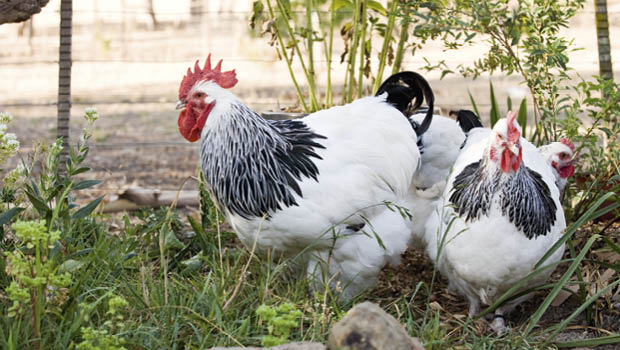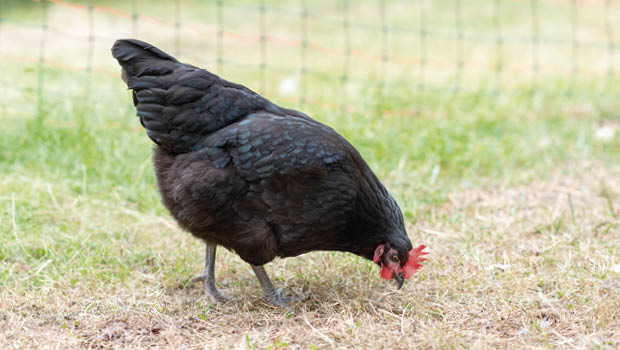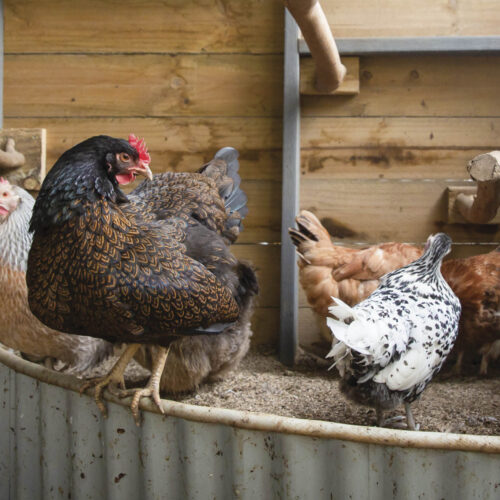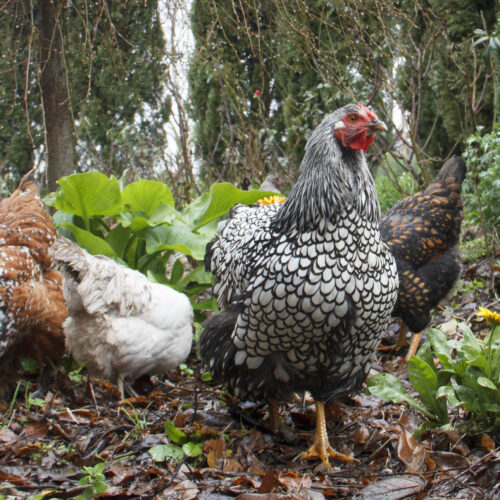Heritage hens
2021-02-02T23:51:35+11:00
The top performers of yesteryear, heritage poultry breeds are slow-growing, long-laying and one of the keys to our long-term food security.
If you grow heirloom vegetables for their variety and authentic flavour, why not complement these with a heritage breed of fowl? The top performers of yesteryear, these breeds are productive, hardy and long-lived. While they have struggled to compete against recent hybrids, our heritage breeds are beautiful, well adapted to our climate, and a repository of valuable genetic diversity.
Heritage poultry have historical significance, having been developed before the mid 20th century and being among the foundation breeds of the modern poultry industry. By choosing to raise these breeds, we can help preserve their diverse practical traits – a valuable insurance against future food security challenges. One of the most notable traits is their ability to lay well into their older years, while males remain fertile and active. Hybrids by contrast are bred to produce lots of eggs in their first few years and are not typically long-lived.
Heritage breeds are adapted to outdoor management, thrive in a range of conditions, and are able to engage in natural activities, such as mating and scratching. They also have moderate-to-slow growth, developing over a natural timeline which results in qualities such as more flavoursome meat, for example.
Four top picks
Australorp
The quintessential Aussie chook, the Australorp (pictured above) started as the Black Orpington, a dual-purpose breed developed in the UK and imported into Australia after 1890. Here, Orpingtons were outcrossed with Minorcas, White Leghorns and Langshans, transforming it into an excellent egg producer.
The Hawkesbury Agricultural College held a six-month egg-laying contest in 1902 with Black Orpingtons the surprise winners. Their success caused worldwide interest and improved Orpingtons were imported into England and America in the early 1920s. A new name was required; the Australorp was chosen.
Utility flocks of Australorps were retained by the laying industry in Australia to breed the crossbreds used as layers for decades. Exhibition Australorps followed a different trajectory: fanciers selected for beauty, abundant feathering and a larger frame, not utility properties. Today there are few of the small bodied laying strain available, but most are the exhibition style.
These stately birds have big black eyes and slate legs and come in Black, Blue and White, in large and bantam. They are relaxed, tend to rule the roost and love their tucker.
The exhibition strain are only moderate layers of middling-sized, tinted (between white and brown) eggs, but look simply stunning on the lawn.
Leghorn
Small-bodied layers called Leghorns originated in Northern Italy, near the port of Leghorn (Livorno in Italian). They were imported into America in 1852, then exported to England in 1870, where they were crossed with Minorcas to add size.
Present in Australia from the 1880s, Leghorns were the mainstay of the government-run laying tests that ran up to the 1980s and were considered the elite athletes of the laying industry. After years of dominance, Leghorns lost favour as commercial birds when brown-shelled eggs replaced white in popularity. These days they are kept for their elegance as a show fowl and reliability as backyard layers.
Leghorns come in large and bantam, in colours including Brown, White and Black, with Black now considered the best layer. They lay large white eggs, and are busy, active birds. Hens rarely go broody.
Leghorns can be flighty and require calm management. They prefer not to be confined and make ideal helpers for any garden project that involves digging, scratching or breaking down weeds and scraps.
Plymouth Rock
Like many heritage breeds, Plymouth Rocks have suffered from the vagaries of fashion. This dual-purpose breed was developed in America in the late 1800s from a combination of breeds including Black Spanish, Grey Dorking, Dominique, Black Java and more. Multiple strains were created which were amalgamated into the Plymouth Rock, America’s first recognised poultry breed.
The Barred Rock was admitted into the American Standard in 1874 and imported into Australia around the same time, causing a splash. It quickly achieved high numbers due to its reputation for laying ability, table properties and sheer size, as well as the appeal of the attractive barred feathering.
After initial popularity, the breed quite quickly fell from top position, replaced by the Orpington and Wyandotte. However, their utility qualities meant Barred Plymouth Rocks (usually known as Barred Rocks) were a common sight in farm flocks throughout the last century, and the White Rock was a major contributor worldwide to the female broiler breeder line. These days, Rocks are fair layers of medium, white-shelled eggs and available in Barred as well as: White, Buff, Black and Partridge.
Developed as the ideal farm fowl, Rocks are still an excellent choice for a smallholding; combining a relaxed nature with hardiness, longevity, and good brooding and mothering qualities.
Sussex
A true old-fashioned fowl, the Sussex (pictured below) was developed in the 1800s as a table bird to supply the London market. Bred from the Dorking, it was considered a better layer and graced every rural Sussex cottage. The Sussex was formally acknowledged as a breed in England in 1903 and by 1915 Sussex classes were common at Australian poultry shows.
It was kept on farms as a dual-purpose fowl (for eggs and meat) but underwent selection for improved laying qualities, and was often crossed with Indian Game for the table. The hens lay a moderate number of eggs, and retain broodiness and mothering abilities.
Sussex take everything in their stride, and are ideal for families. They are hardy in most climates except very hot, as their profuse feathering and large frame leaves them vulnerable to heat stress.
Available varieties include Light (white), Speckled, Buff and Coronation, in large and bantam. Sussex won’t destroy the garden like a more active breed, but when they dig a crater to dust bath in, expect a decent hole. And they love food; you have been warned!

Some more options
There are many more heritage breeds to choose from, here are a few others that might take your fancy:
- Anconas are smart, active birds that remain excellent layers of large, creamy-white shelled eggs.
- The Silver Grey Dorking is a traditional English table bird with a long history, and is a real backyard beauty.
- The Hamburgh is a stunning breed with excellent heat tolerance and laying persistence.
- Wyandottes are placid natured with gorgeous feathering, and were kept as dual-purpose fowls.
- The Australian Langshan is economical and hardy and is still the top purebred layer.
Where to buy
To view heritage breeds, have a day out at a local poultry or agricultural show. Most breeds have a breed club, which will offer advice and contacts for stock. These are listed in the directory pages of Australasian Poultry magazine, and usually have a searchable Facebook page or website. Try to buy stock from your general area as they will be well adapted to local conditions. Online sites such as Gumtree can also be useful for sourcing stock but buyer beware!
Jessamy Miller is our chook expert and has written many features and blogs for OG about raising happy and healthy chickens. Subscribe here to get the magazine and more expert advice delivered to your door!
For more information on backyard chooks try the following:
Keeping chooks in small spaces






